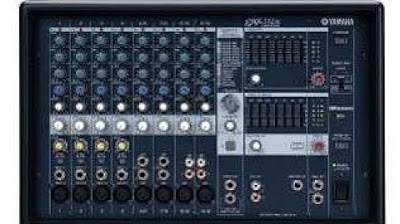W5_L1_Analog Mixer
Summary
TLDRIn this video, the discussion explores the behind-the-scenes process of live concert audio mixing, particularly focusing on balancing sound levels for multiple instruments. It delves into the use of audio mixers to adjust mic inputs and ensure a cohesive performance. The video also demonstrates a simple circuit design using Kirchhoff’s Laws and potentiometers to manipulate audio signals, explaining how voltage and current adjustments can control amplitude. Practical experiments with different signal types, including amplitude modulation and mixing DC with AC, are showcased to highlight real-world applications of these concepts in audio engineering.
Takeaways
- 😀 Live music concerts often involve multiple instrumentalists (up to 25 or more), including string, wind, and percussion instruments.
- 🎶 The role of an audio mixer is crucial in adjusting the volumes of different instruments, ensuring a balanced mix during performances.
- 🔊 Audio engineers adjust microphone positions and volume levels to create the ideal sound mix for each instrument in a live setting.
- 🎚️ Audio mixing involves not just volume control, but sophisticated mixing of different frequencies to ensure clarity in the final output.
- 🔌 An audio mixer works by adjusting the voltage levels of multiple signals, which are then combined to create a single output signal that represents the full sound of the concert.
- 📡 Sound mixing in a concert is like manipulating electrical signals in a circuit, where different inputs (mic signals) are combined and adjusted for volume and clarity.
- 💡 Key electrical concepts used in audio mixing include voltage loss, current loss, and the use of circuits to control sound volume through adjustments in current and voltage.
- 🔧 Practical demonstrations using circuits, such as voltage sources, resistors, and potentiometers, can help explain the theory behind audio mixing.
- 🎚️ The use of a potentiometer in the hardware setup allows for real-time adjustments in signal strength, similar to how sound engineers adjust levels during a live concert.
- 📊 Mixing different frequencies, such as combining 1 kHz and 10 kHz sinusoids, results in amplitude modulation, demonstrating the complexity of sound mixing in real-world scenarios.
- 🎤 In a live concert, the sound engineer controls how different signals (e.g., vocals, instruments) are mixed and adjusted for optimal sound output, a process that mirrors electrical mixing circuits.
Q & A
What is the main role of an audio mixer in a concert setting?
-The main role of an audio mixer in a concert is to adjust the volume levels of multiple sound sources, including microphones, instruments, and vocalists, ensuring they blend together harmoniously for the audience. This is achieved by controlling the levels through various channels and knobs on the mixer.
How does an audio mixer ensure that all instruments are heard clearly during a concert?
-An audio mixer uses volume control, equalization, and balance adjustments to ensure that all instruments and sound sources are mixed appropriately. This helps manage louder instruments like drums and softer sounds like vocals so that they all contribute clearly to the overall sound.
What is the significance of the number of channels in an audio mixer?
-The number of channels in an audio mixer indicates how many separate audio inputs it can handle. For instance, a 16-channel mixer can handle 16 different sound sources simultaneously, with each input having its own volume and equalization controls.
What does the term 'amplitude modulation' refer to in the context of audio mixing?
-Amplitude modulation refers to the process where the amplitude (strength) of one signal is varied by another signal, often resulting in a wave that exhibits a frequency modulation pattern. In the script, it is shown as combining two sine waves of different frequencies (1 kHz and 10 kHz), creating a complex output.
How does the concept of Kirchhoff's Current Law (KCL) apply to the audio mixing circuit discussed in the script?
-Kirchhoff's Current Law (KCL) states that the total current entering a node in a circuit must equal the total current leaving the node. In the context of the audio mixing circuit, it ensures that the currents from the two input signals combine correctly at the node, which contributes to the final mixed output.
What is the purpose of using a potentiometer in the audio mixing circuit?
-A potentiometer is used to adjust the resistance in the circuit, which in turn adjusts the amplitude of the output signal. This allows for real-time control of the mix between two signals, enabling fine-tuning of the volume balance in the audio mix.
What happens when two sine waves of different frequencies (e.g., 1 kHz and 10 kHz) are added together in an audio mixing circuit?
-When two sine waves of different frequencies are added, the result is not just a simple sum but a combination that includes components of both frequencies. This results in a waveform that contains both a low-frequency envelope (1 kHz) and high-frequency components (10 kHz), demonstrating the principle of amplitude modulation.
How does the circuit adjust the amplitude of the output signal (VX)?
-The amplitude of the output signal (VX) is adjusted by changing the resistance in the circuit, either through fixed resistors or a variable resistor (potentiometer). This adjusts the voltage at the node, effectively controlling the strength of the mixed signal.
Why is it important to balance the audio mix in a concert with multiple instruments?
-Balancing the audio mix in a concert ensures that each instrument and voice is heard clearly without overwhelming others. For example, drums are often louder, but without proper mixing, they could drown out quieter instruments like the guitar or vocals. Proper mixing provides clarity and a harmonious sound experience.
What is the effect of adding a DC offset to a sinusoidal signal in the mixing circuit?
-Adding a DC offset to a sinusoidal signal shifts the entire waveform up or down on the voltage axis. This means the sine wave will no longer be centered at zero but will oscillate around the DC value, creating a signal with a constant shift in amplitude.
Outlines

Этот раздел доступен только подписчикам платных тарифов. Пожалуйста, перейдите на платный тариф для доступа.
Перейти на платный тарифMindmap

Этот раздел доступен только подписчикам платных тарифов. Пожалуйста, перейдите на платный тариф для доступа.
Перейти на платный тарифKeywords

Этот раздел доступен только подписчикам платных тарифов. Пожалуйста, перейдите на платный тариф для доступа.
Перейти на платный тарифHighlights

Этот раздел доступен только подписчикам платных тарифов. Пожалуйста, перейдите на платный тариф для доступа.
Перейти на платный тарифTranscripts

Этот раздел доступен только подписчикам платных тарифов. Пожалуйста, перейдите на платный тариф для доступа.
Перейти на платный тарифПосмотреть больше похожих видео
5.0 / 5 (0 votes)






